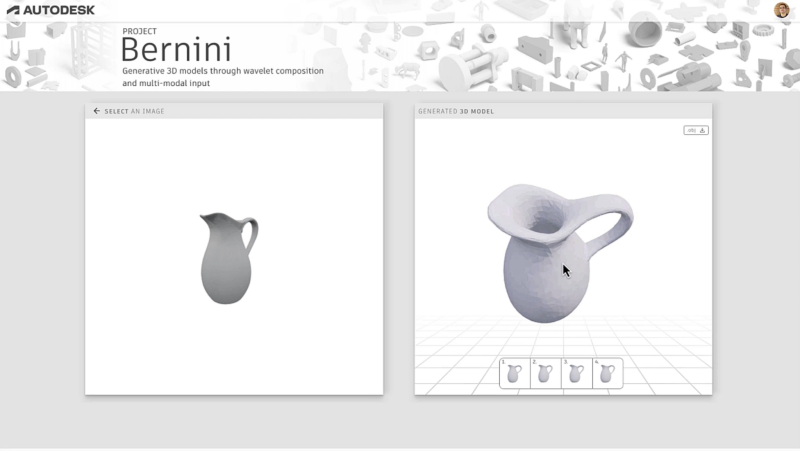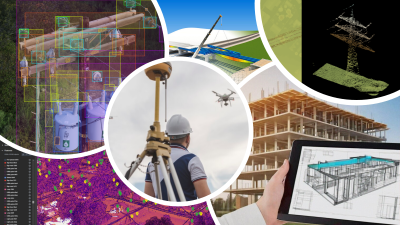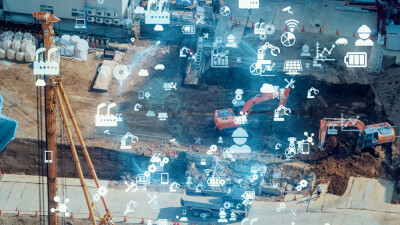Much like most every company across industries right now, Autodesk is leaning heavily into the current AI boom. Given the industries they serve, most notably AEC and manufacturing, finding ways to streamline tedious workflows with new capabilities opened up by more funding and compute for AI makes sense. It’s been a big part of their most recent product rollouts, as well as being the primary focus of last year’s Autodesk University event.
Earlier this month, the company announced their latest foray into the cutting edge in AI, announcing Project Bernini, a new effort from the Autodesk Research team. In their announcement of the news, they say the team “trained the Bernini model on ten million diverse 3D shapes—a composite dataset made up of publicly available data, a mixture of CAD objects and organic shapes. Research that contributed toward this work was published earlier this year by the AI Lab in collaboration with the Chinese University of Hong Kong.”
At its most basic, Project Bernini is something that we’ve seen from some other companies, using generative AI to create 3D models. The model is able to create these models from a few different input types, including text, a single or multiple 2D images, point clouds, and voxels. They note that they are “applying a generative approach that produces several variants,” which in theory should provide more choice to the human on the other end. Right now, Project Bernini is “strictly experimental,” and is currently not available for public use.
Ultimately, Autodesk indicates that they are working to create generative models that can be used across their customer base, which includes professionals not only in the AEC industry, but also make and design as well as media and entertainment. They emphasize that, in order to accomplish these goals, the models that are generated must be as physically realistic as possible.
“We’re intently focused on generating functional 3D structures because the articles built or manufactured from the outputs of these models must work in the real world, serving the purpose that the designer has in mind,” they said in their announcement of this project.
Autodesk gives the example of a water pitcher (pictured at the top of this article) as how this is applied in a real-world scenario. They note that other generative 3D creation models would produce shapes that look like a pitcher, but that Bernini models generate shape and texture separately “and does not confuse or meld those variables.” The result is a water pitcher that is hollow in the middle and could actually hold water, allowing for these models to interact in something close to real-world scenarios.
Given that the development of this model is still in the relatively early stages, there is unsurprisingly little focus on specific use cases or industries. Their brief mentioning of the AEC industry said: “If trained on buildings, the models could generate geometrically rigorous creative designs and inspire a new generation of buildings and architects.”
It’s at this point where one might see some differing opinions about the use of generative AI in building design. Autodesk references their 2024 State of Make & Design Report – which covers all of the aforementioned industries under their umbrella – in which 78 percent of polled business leaders say they believe AI will enhance their industry and that 79 percent agree that AI will make their industry more creative. Of course, the opinions of business leaders don’t always match those that work under them, who may not be as excited about generative design models for a variety of reasons, among them being that generative AI being used in building design could theoretically result in a number of very similar looking buildings.
Ultimately, we are in the very early stages of not only this Bernini model but also generative AI for 3D model creation in general. It’s far too early to talk about ultimate consequences, though it goes without saying that this should be front of mind for any company involved in the creation of these models. (Autodesk, to their credit, does have processes in place to ensure trust and transparency is involved in their AI work.) In an industry like AEC that is dealing with increasing demand and decreasing workforce sizes, any way to reduce workloads is going to be welcome. It’s just about finding the right way to make those implementations.
To that end, Autodesk says they are looking for potential partners to test and improve this kind of work.
“As the team works to refine this technology, Autodesk is actively engaging potential partners to further study and improve the performance of generative models for design and make. While Project Bernini is exciting and at the leading edge of generative AI, its models will become increasingly useful and compelling when trained on larger, higher-quality professional datasets. The Bernini model is specifically structured to offer efficient training and fine-tuning to easily allow this.”






